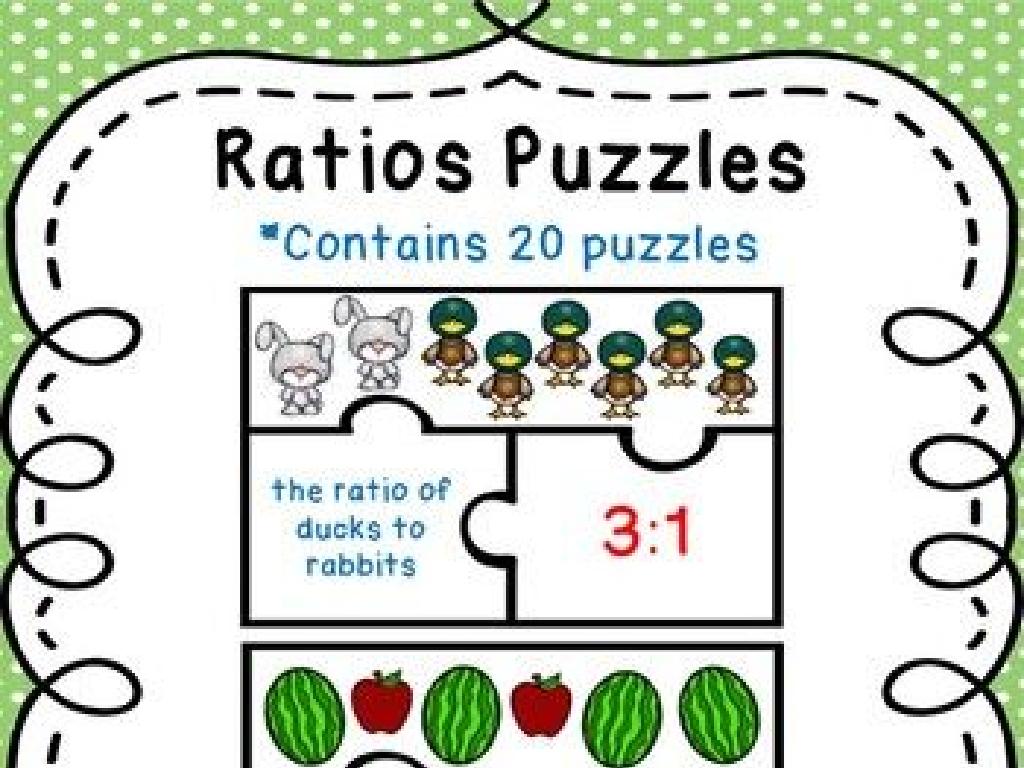Dilations: Find The Scale Factor
Subject: Math
Grade: Eighth grade
Topic: Transformations And Congruence
Please LOG IN to download the presentation. Access is available to registered users only.
View More Content
Dilations and Scale Factors
– Exploring transformations
– What are dilations?
– Dilations involve resizing without altering the shape.
– Determining scale factors
– Scale factor is the ratio of the size of the new shape to the original.
– Real-world applications
– Maps, models, and resizing images are practical uses of dilations.
|
This slide introduces students to the concept of transformations with a focus on dilations and scale factors. Begin by discussing transformations as operations that alter the position or size of shapes. Explain dilations as a type of transformation that changes the size but not the shape, and how the scale factor is a crucial component in performing dilations correctly. Emphasize the importance of understanding scale factors through real-world examples such as map reading, creating models, or resizing digital images. Encourage students to think of other examples where dilations are used and how scale factors play a role in those scenarios.
Understanding Dilations in Geometry
– Define dilation in geometry
– A transformation altering a figure’s size
– Dilations: enlargements or reductions
– Dilations can increase or decrease the size of a figure
– Proportionality in dilations
– All lengths in a dilation are scaled by the same factor
– Scale factor determination
– The ratio of any two corresponding lengths in the image to the pre-image
|
This slide introduces the concept of dilation, a type of transformation in geometry that alters the size of a figure. It’s crucial to emphasize that dilations can either enlarge or reduce figures, but they maintain the shape’s proportionality. The scale factor is a key concept; it’s the multiplier used on each dimension of the figure to achieve the dilation. When teaching this concept, provide examples of both enlargements and reductions, and demonstrate how to calculate the scale factor by comparing corresponding lengths of the pre-image and the image. Encourage students to practice finding scale factors with various figures to solidify their understanding.
Understanding Scale Factor in Dilations
– Define Scale Factor
– Ratio of corresponding lengths in a dilation
– Scale Factor > 1: Enlargement
– Objects increase in size; e.g., a map scale of 1:1000
– Scale Factor < 1: Reduction
– Objects decrease in size; e.g., a photograph reduced to a thumbnail
– Practical applications
|
The scale factor is a crucial concept in understanding dilations in geometry. It is the ratio that describes how much a figure is enlarged or reduced during a dilation. A scale factor greater than 1 indicates that the figure is being enlarged, which can be seen in real-world applications like enlarging a map for better readability. Conversely, a scale factor less than 1 signifies a reduction, such as when a photograph is shrunk to create a thumbnail image. It’s important for students to grasp this concept as it applies to various aspects of mathematics and everyday situations. Encourage students to bring examples of dilations they encounter in their daily lives to discuss in class.
Calculating Scale Factor in Dilations
– Steps to find scale factor
– Measure original & dilated lengths, then divide.
– Example: Dilation from a point
– If a figure grows from 2 to 6 units from the center, scale factor is 6/2 = 3.
– Practice Problem on scale factor
– Given two figures, calculate the ratio of their corresponding sides to find the scale factor.
|
This slide is aimed at teaching students how to calculate the scale factor in dilations, which is a type of transformation in geometry. Start by explaining the process of finding the scale factor by measuring the original and the dilated lengths of a figure and then dividing them. Use a clear example where a figure is dilated from a center point, and the lengths of the sides are increased proportionally. Provide a practice problem where students are given two similar figures and asked to find the scale factor by calculating the ratio of the corresponding sides. This exercise will reinforce their understanding of scale factors and how to apply them to dilations.
Properties of Dilations
– Dilations keep angles constant
– Angles in the figure stay the same after dilation
– Size changes, shape remains
– Only the size of the figure is altered, not the shape
– Proportional sides maintained
– Sides of the figure are multiplied by the same scale factor
– Scale factor determines size
– The ratio used to enlarge or reduce a figure
|
This slide introduces the key properties of dilations in the context of geometric transformations. Emphasize that dilations result in figures that are the same shape but different sizes, with angle measures preserved. It’s crucial for students to understand that all corresponding sides of the original and the dilated figure are proportional, meaning they are scaled by the same factor. The scale factor is a critical concept and determines how much larger or smaller the dilated figure will be compared to the original. Provide examples of dilations in real life, such as resizing an image on a computer or the shadow cast by an object in the sun, to help students visualize the concept.
Dilations: Scale Factor in Real-World Applications
– Scale in maps and blueprints
– Maps use a scale factor to represent large areas on a small surface.
– Similar figures in art and design
– Artists create different-sized but similar artworks using scale factors.
– Proportional zoom in photography
– Photographers maintain image proportions by adjusting the scale factor when zooming.
|
This slide aims to show students how the concept of dilations and scale factors is applied in various real-world scenarios. When discussing maps and blueprints, emphasize how scale factors allow for accurate representations of space on a smaller, manageable scale. In art and design, understanding scale factors enables artists to create multiple works of the same subject with consistent proportions. Photography provides a tangible example of dilations, as zooming in and out changes the size of the subject while keeping its proportions the same. Encourage students to think of other examples where scale factors are used and discuss the importance of maintaining proportions in these applications.
Class Activity: Discovering Scale Factors
– Objective: Identify real-life scale factors
– Materials: Rulers, photos, scaled objects
– Instructions: Measure objects’ scale factors
– Use rulers to measure actual and scaled dimensions
– Calculate and compare different scale factors
– Apply the formula: Scale Factor = Scaled size / Actual size
|
This activity is designed to help students understand the concept of scale factors through hands-on experience. Provide students with rulers, a variety of photographs, and objects that are scaled models of real-life items. Students will measure the dimensions of the objects and their corresponding images to calculate the scale factor. Encourage them to compare scale factors of different objects to understand how scaling works in various contexts. Possible activities include measuring a toy car and comparing it to the dimensions of a real car, or using a photograph of a classroom and measuring furniture to find the scale. This will solidify their understanding of dilations and scale factors in a tangible way.
Conclusion: Dilations and Scale Factors
– Recap: What are dilations?
Dilations involve resizing without altering the shape.
– Homework: Scale factor of home object
Choose any object, snap a photo, and calculate the scale factor.
– Understanding scale factor
Scale factor is the ratio of the dimensions of the image to the pre-image.
– Next class: Similarity in figures
|
As we wrap up today’s lesson on dilations, remember that a dilation is a transformation that produces an image that is the same shape as the original, but is a different size. For homework, students are to find an object, take a picture, and determine the scale factor by comparing measurements. This will help reinforce their understanding of how to apply scale factors to real-world objects. In the next class, we will build on this knowledge by exploring how similar figures relate to each other through the concept of similarity, which also involves understanding proportions and scale factors.






